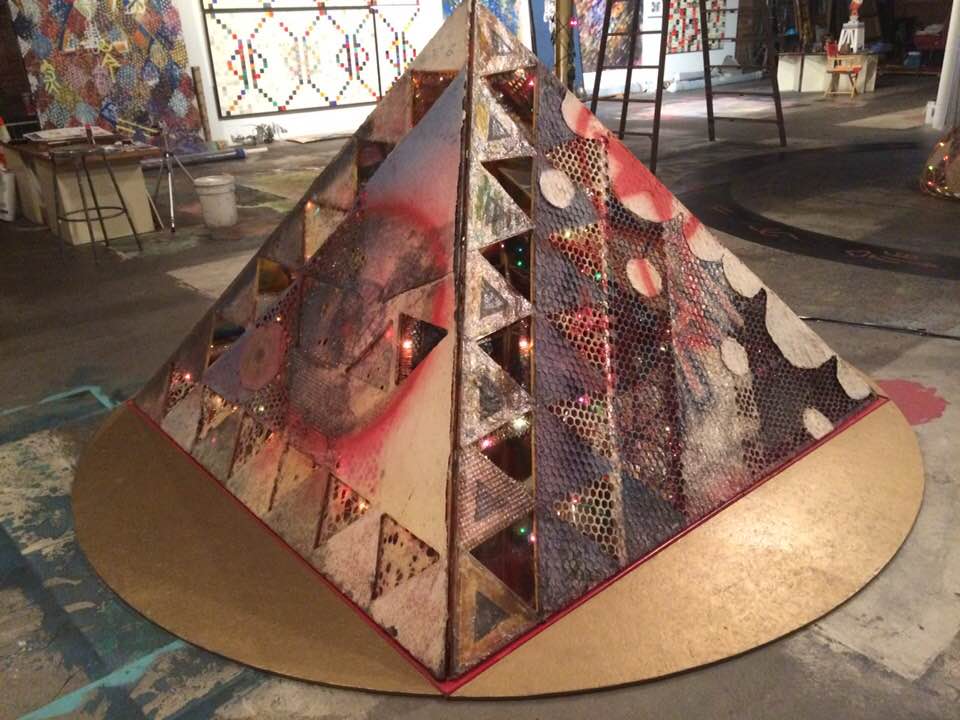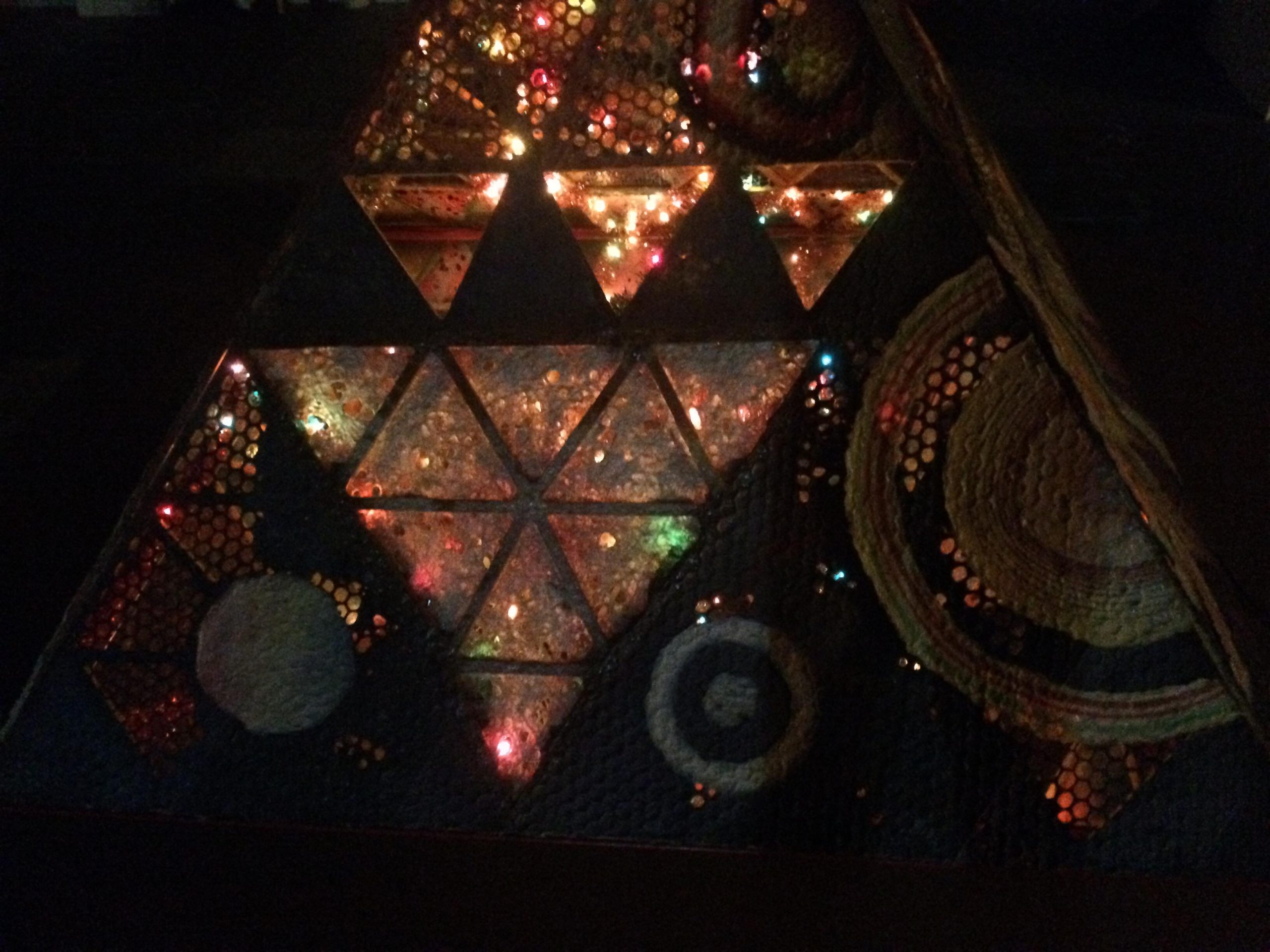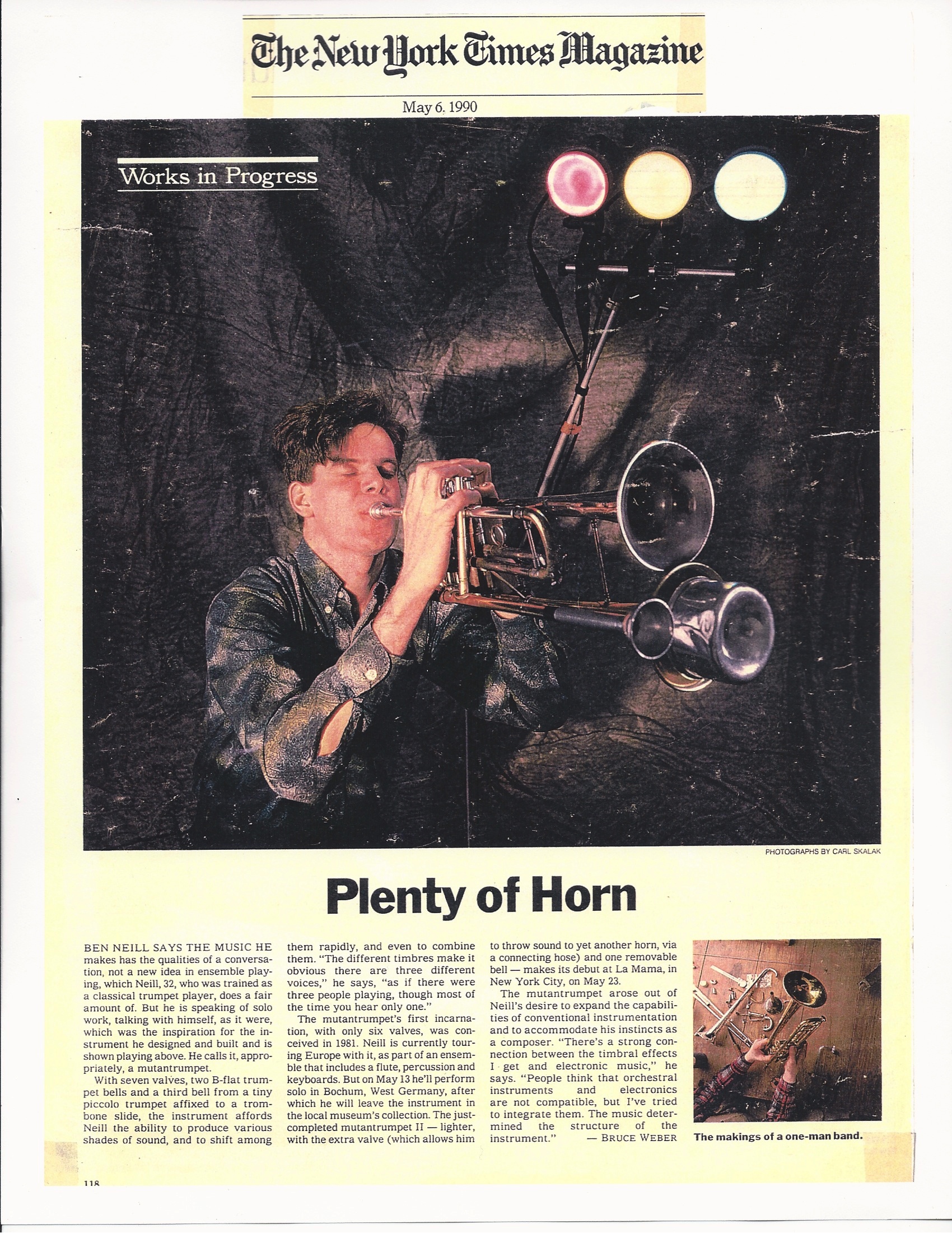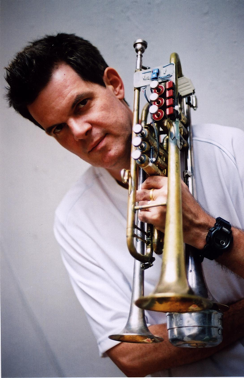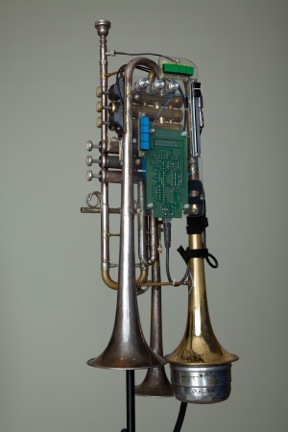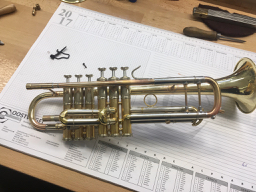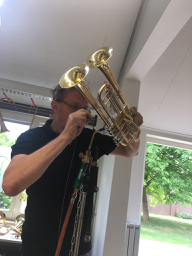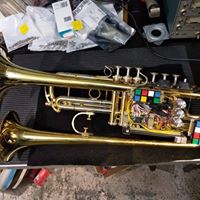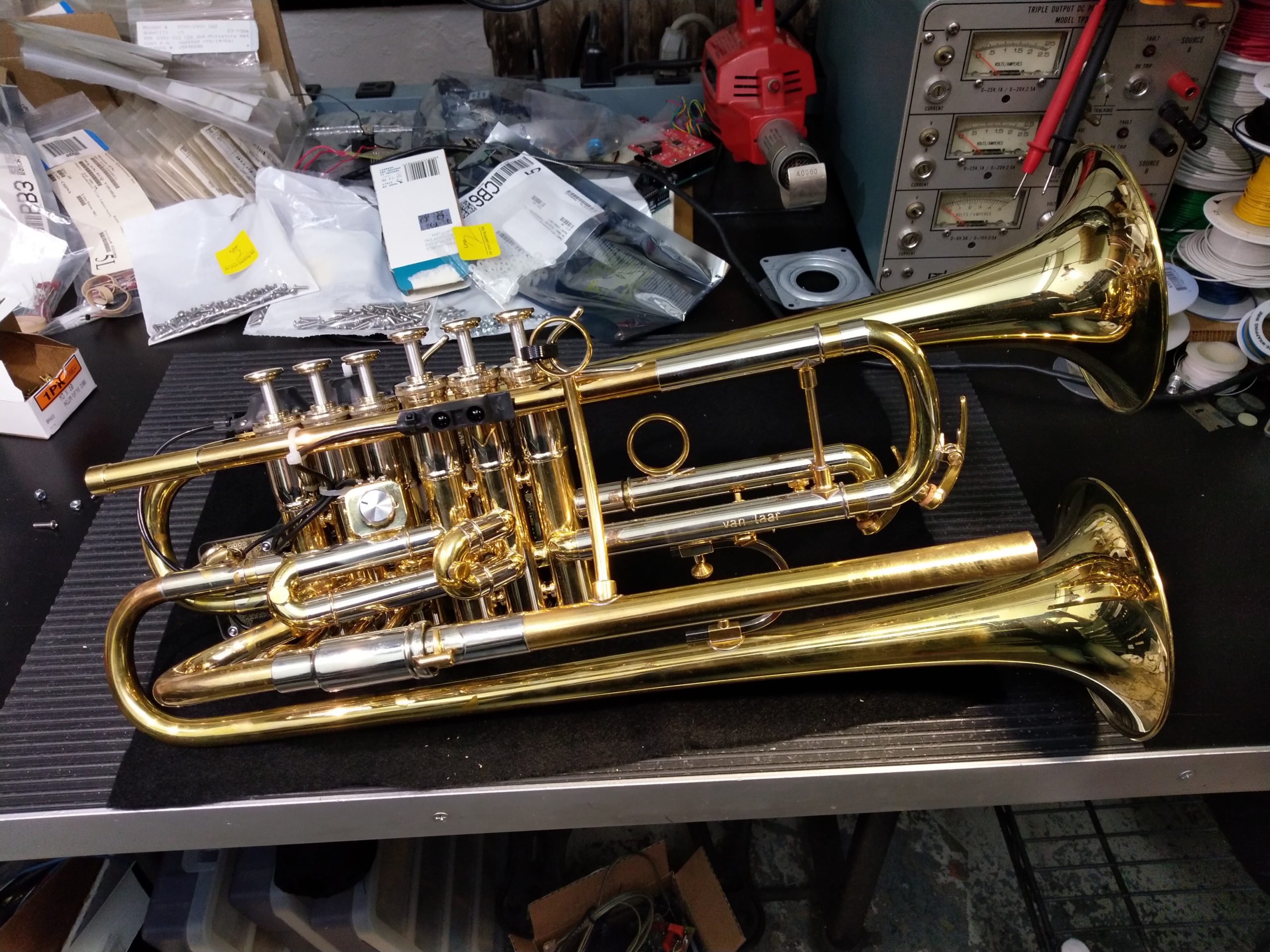I began developing the Mutantrumpet in the early 1980’s while completing my Master’s Degree in trumpet performance at the Dana School of Music in Youngstown, Ohio. During these formative years I developed a strong interest in avant-garde music and performed a wide variety of music by contemporary composers. The music I was studying at that time made use of many timbral modulations through the use of mutes and extended playing techniques. The music and writings of John Cage and Karlheinz Stockhausen were a major influence on my thinking. In his interviews with Jonathan Cott, Stockhausen spoke about how instruments needed to be reinvented for the contemporary age, incorporating electronics and extending their conventional techniques:
Musicians who play new instruments could demonstrate unaccustomed instrumental possibilities and also novel uses of mikes and contact mikes and transformation devices which modulate and change the instrumental timbres. (Cott 1974)
Around this time I started to become disillusioned with the idea of a conventional classical music career, even though I had made the finals in my first few orchestral auditions. While contemporary classical music held a strong interest for me, my musical tastes were quite diverse and I was particularly passionate about the art rock of David Bowie, Brian Eno, and Todd Rundgren the electro-jazz experiments of Miles Davis, Jon Hassell, and the Mahavishnu Orchestra, and the emerging sounds of punk and new wave. The experimental puk/new wave scene in Northeast Ohio was thriving, with bands such as Devo, Pere Ubu and Carsickness incorporating experimental sounds and ideas into popular music forms. In 1980 I started the B-Minors along with bassist/guitarist John Chianese and percussionists Jody Rizer and Don Yallech. Our first show was at the Butler Art Institute in Youngstown, and we became regulars in clubs such as The Bank in Akron, JB’s in Kent, and the Cedars in Youngstown. I played guitar and keyboards in addition to trumpet in the B-Minors, but it was in this context that I started experimenting with modifying the trumpet by putting a removable trumpet bell on the first valve slide of a normal trumpet. This allowed me to experiment with multi-timbral muting effects acoustically, however, it defeated the normal pitch function of the first valve which severely limited the utility of the instrument. The timbral shifting was compelling however, and led me to think about creating a different instrument that would expand on that idea.
The genesis of the Mutantrumpet happened shortly thereafter as I sat in this pyramid artwork with a mirrored floor created by artist Jim Pernotto. The sensation of floating was enhanced by the fact that I was under the effects of a strong hallucinogenic substance for the first time, and the idea for the instrument completely took shape during that experience.
I envisioned the Mutantrumpet as the focus of a composer/performer project, an expanded version of the acoustic trumpet with electronics as an integral component. I was drawn to the world of electronic sound, having recently purchased my first synthesizer, a Korg MS 10, and working with a Serge modular system at Youngstown State. These were important tools in my development, but I was hoping to create a stronger connection between the acoustic and electronic. My goal was not just to create a vehicle for producing extended techniques, but rather to build an instrument system that could be the conceptual foundation for a compositional approach based on notions of hybridity and amalgamation, to which I was instinctually drawn. Emulating electronic sounds in the acoustic realm through timbral manipulation and then further processing those sounds with electronics was the fundamental concept of my original design, and has remained so up to the present time.
Shortly after my epiphany in Pernotto’s pyramid I worked with brass instrument technician Rob Cole to create the first acoustic Mutantrumpet. Cole was a French hornist in my brass quintet at the time and had worked at the King instrument factory in Elkhart, Indiana. The first version was cobbled together from two beat up Bundy student trumpets. It had two bells with an extra set of valves for switching between the bells, and also a quartertone valve. I didn’t have a case for it initially, so I carried it around in a laundry bag. In 1983 I contacted Robert Moog, who was doing custom work through his company Big Briar, to see if he might be able to create an electronic processing system for it.. He invited me to visit him at his home/workshop in Asheville, NC, and he took a great interest in my project. Moog designed my first system for integrating the acoustic Mutantrumpet with electronics, consisting of a Gentle Electric Pitch to Voltage Converter, a small rack of analog synthesizer modules, and several custom voltage control interfaces. In 1984 Moog was working with Ray Kurzweil on the first touch sensitive MIDI keyboards. He invited me to his home in Newton, MA, to pick up my synthesizer and spent several days with me exploring interface and sonic possibilities with the new instrument.
Photos by Robert Moog, ca. 1982
We remained friends and frequently saw each other until his passing in 2005. This was in the early days of MIDI, and pitch to MIDI devices were just starting to come on to the scene. the was the first one to appear. While working with Moog he also introduced me to the IVL Pitchrider and the idea of a MIDI-capable acoustic instrument. Just prior to moving to New York City in 1983 Cole created the second version of the mutantrumpet which I played for the next decade.
In 1984 I moved to New York City, and shortly thereafter I bought my first computer, an Atari 520 ST, and an IVL Pitchrider. This brought me into a new phase of my work with live electronics. Around the same time I began working with David Behrman on a series of pieces for his interactive electronics system, and this was an extremely influential part of my development as a composer/performer. Behrman was creating interactive pieces that were activated by live musicians, and through this experience I became introduced to the possibilities of an intelligent dialogue between acoustic playing and computer-generated sound. These works can be heard on the recordings Leapday Night and Unforeseen Events. During this period I began composing my first pieces that incorporated a computer into their live performance; Dis-Solution 2 (1986), a notated piece which used a combination of digital and analog synthesis and a pitch-sensing program by Behrman, with live percussion; Money Talk (1987), a structured improvisational work for mutantrumpet and percussion based on the vocalizations of a tobacco auctioneer, and a series of brass, guitar and percussion ensemble pieces which combined early Baroque brass music with contemporary musical forms. These pieces were released on my first CD, Mainspring, Ear-Rational (1988), which will be re-released later in 2019.
As I continued to perform and to collaborate with many musicians in the downtown New York music scene, the original mutantrumpet was in need of revamping. While on tour with Petr Kotik and the SEM Ensemble, I was introduced to the director of the Museum Bochum, Germany, which has a sizable musical instrument collection. The museum was interested in purchasing my original mutantrumpet, and this development allowed me to pursue creating a new version of the instrument with some improvements. In 1990, a new acoustic version of the trumpet was built by Cole. The new instrument incorporated a new element, a piccolo trumpet bell attached to a trombone slide that enabled a true glissando. Shortly thereafter my duo project with Nicolas Collins brought me to the STEIM studios in Amsterdam, where I was introduced to the array of new performance technologies being developed there. I was offered a residency to further develop my instrument, and during this time I was able to greatly expand the computer interactive capabilities of the mutantrumpet. The design used 4 switches, a potentiometer, and 2 pressure sensing pads to send MIDI controllers in addition to my notes and dynamics through a Yamaha MCS2. At this time I was also introduced to the STEIM software applications such as the Lick Machine, which greatly facilitated my exploration of live interactive performance.
With a new, much more powerful instrument in hand, I was ready to embark on a set of pieces that used electronics in a more deeply interactive way. Up until this time I had been primarily performing in the context of experimental avant-garde music both in the US and Europe. However, my own musical interests continued to tend away from classical music toward popular culture, and my work with Rhys Chatham’s rock guitar orchestras in the 1980’s contributed to my belief that it was possible to bring the vocabulary of popular music into the realm of the concert hall. Electronic trumpeter Jon Hassell, who was a very important mentor to me in during my early years in New York, had encouraged me to move more in the direction of popular music rather than staying in the avant-garde classical world. My early compositions all utilized visceral rhythmic material from the popular music vocabulary along with the exploratory sensibilities of the mutantrumpet. My other strong influence in my first decade in New York was La Monte Young, with whom I worked on a new version of his piece The Second Dream of the High Tension Stepdown Line Transformer. Young introduced me to just intonation and his drone sensibility, which I had been exploring prior to meeting him, but was greatly expanded through our association. His work with frequency rations and numerical systems fascinated me, and I sought to apply these concepts to broader aspects of my compositions through a concept I called rhytharmonics.
When I was introduced to the electronica/rave scene in the early 1990’s I was immediately very excited by this new strain of musical expression in which experimentation was embraced by a new generation of artists and audiences. My music was already characterized by repetitive beats and ambient textures, and I immersed myself in the electronica culture, creating a series of works that could be performed in this newly emerging arena alongside DJs and purely electronic musicians. Once again, aesthetics and technology converged in a very interesting way which produced a whole new result. Through this development I was able to find a larger audience for my work, and since 1992 I have continued working in the realms of DJ culture, electronica, drum and bass, dubstep, and other forms of popular electronic music. However, my approach to these musical forms has always remained somewhat singular since most of the practitioners were primarily DJs, not instrumental performers. My entire artistic project has been to bring the experimental instrument design and performance capabilities of the mutantrumpet into a visceral, accessible musical context, which I continue to pursue today.
In 2004 I began designing version 3 of the mutantrumpet based on the Junxion system from STEIM with Frank Balde and Jorgen Brinkmann. The physical instrument was built from a trumpet I already owned and spare parts by Terry Pierce, a brass instrument technician in New York City, along with James Lo, a hardware and software programmer. Version 3 featured an ergonomic design which included 8 continuous MIDI controllers and 8 momentary MIDI controllers in addition to the acoustic note and volume control from the instrument’s natural sound. Version 3.0 has three bells, two sets of valves, and a trombone slide. The extra set of valves controls switching between the 3 bells, frequently different mutes are used to give each bell a distinctive timbral quality. There are two normal Bflat trumpet bells, a quartertone valve, and one piccolo trumpet bell that is attached to a trombone slide.
The acoustic trumpet sound is converted to MIDI data via a pickup in the mouthpiece connected to a pitch to MIDI converter. The converter generates Note, Velocity, Volume and Aftertouch information. A Steim Junxion board mounted under a plate of clear Lexan plastic powers the 8 momentary switches on the Lexan panel, as well as three continuous MIDI controllers in the form of potentiometers and a fader. On top of the bell, right next to the second set of valves, are two joysticks with X/Y axis controls. There is one other potentiometer on the first valve slide, on the other side of the instrument body. The mutantrumpet connects to the computer via USB; the Junxion software program maps the controllers on the board to a variety of routings. Many different configurations can be created in Junxion, including tables which shape the response curves of the controllers, a very useful feature. There is a clip-on microphone attached to the bottom bell, this makes the acoustic sounds of the instrument available for processing. All MIDI notes are generated by the mouthpiece pickup, which helps to minimize feedback or glitching of the Pitch to MIDI device. Software applications frequently used include Junxion, LiSa, the Steim live sampling program, Ableton Live, Jack Router, and Logic Pro.
During the 1990’s I also continued to develop my approaches to working with visual elements in my musical performances. The new context of the electronica/DJ culture was very conducive to this pursuit. As new technologies have become available I have explored many different ways of interacting with visual elements. In 1994 I developed a MIDI controllable slide projector interface with engineer Bob Bielecki for my Green Machine installation at Paula Cooper Gallery and the Sci Fi Lounge tour with DJ Spooky and Emergency Broadcast Network in 1996. In the mid-90’s I began collaborating with visual artist Bill Jones, and we moved into the realm of MIDI controllable video, first using the Image/ine system from STEIM. The appeal of the interactive visual elements in performance increased as the technologies became more advanced. In addition to adding a more integrated aesthetic to the live event, the visual interaction helped to clue audiences in to the structure and functionality of the work, which sometimes is difficult for those unfamiliar with interactive performance systems to grasp.
With the emergence of VJ software such as Modul8 and Resolume, I continued to refine my system of programming and structuring environments for live performance. As the system developed, improvisation became a more important part of my aesthetic. Once again, the technology and the aesthetics continued to feed back on each other.
…the only way to find things out about what happens when complex objects such as media systems interact is to carry out such interactions – it has to be done live, with no control sample. (Fuller 2005)
Today, improvisation seems to be the most compelling approach for performing live with interactive systems of all types. Interactivity strongly implies improvisation, and improvisatory elements help audiences to comprehend the meaning of interactive performance gestures while also enabling the possibility of audience interaction. The degree to which it is employed can vary widely, but some element of spontaneity is demanded by the new interactive interfaces that are being designed today, all of which can create and control “media ecologies”:
Multiplicity is induced by two processes: the instantiation of particular compositional elements and the establishment of transversal relations between them. The media ecology is synthesized by the broke-up combination of parts. (Fuller 2005)
The design of Version 4 of the mutantrumpet began in 2014. It became apparent that the STEIM hardware and software were not compatible with new Mac operating systems, so an upgrade was necessitated. Frank Balde recommended the Teensy board for this instrument along with RoSa and a software based pitch follower, and began mocking up a version of it during a Summer 2014 residency. James Lo and I began creating a template for the control panel, keeping it as close to Version 3 as possible to preserve the technique that I’ve developed with that instrument.
Rather than using parts of used instruments as I had in the past, this time I wanted to have the physical instrument fabricated from scratch to incorporate more modern brass technology. It was important to me that Version 3 continue to be operational for all of my existing repertoire, so refitting that instrument was not an option. Through my recent work in Europe with Marco Blaauw and other European trumpeters in performances of La Monte Young’s The Second Dream, I was introduced to Hub van Laar, founder of Van Laar Trumpets. Hub was willing to build a new mutantrumpet for me based on the design of the old instrument. I visited his shop in Termaar, Netherlands several times, and actually got to watch as he and his assistant built the instrument from two B3s.
When the acoustic instrument was complete, James Lo built the hardware controllers for this version as he had for Version 3. The configuration is quite similar, just doubling the number of switches and adding two motion sensors for a total of 28 onboard controllers.
The live sampling software LiSa running with Ableton Live was the backbone of Version 3. For the new instrument I needed update my software to RoSa, the replacement for LiSa. During another residency at STEIM in Summer 2018 I met Jos Zwaaneburg, a flutist and composer whose system strongly resembles mine. Jos has created a Max control software for RoSa, however I sought more customization and at the recommendation of Nic Collins got in touch with Matthew Ostrowski, who has customized Jos’ interface. As of the last month Version 4.0 is up and running, and I will debut it in the premiere performance of Fantini Futuro at Roulette this September.
Hybridity has been a central focus in my work for my entire career. The idea of the hybrid infuses both my technical and aesthetic sensibilities, and the mutantrumpet directly exemplifies this sensibility. During the four decades of development, my approaches to composition and performance have emerged in conjunction with new technological discoveries. As new technological possibilities emerge, music is influenced by those developments, and at the same time new aesthetic ideas influence the invention of new technologies. This has been a continuous process in my work and continues up to the present moment.The experience of creating a new instrument is highly collaborative and necessitates lots of patient trial and error, testing, redesign, and practice. I am extremely grateful to all of the engineers and technicians who have assisted me with the new instrument, and look forward to the debut.
REFERENCES
Cott, Jonathan. 1974. Stockhausen, Conversations with the Composer. London: Picador, 120.
Fuller, Matthew. 2005. Media Ecologies Cambridge: MIT Press, 1.
Fuller, Media Ecologies, 16.
